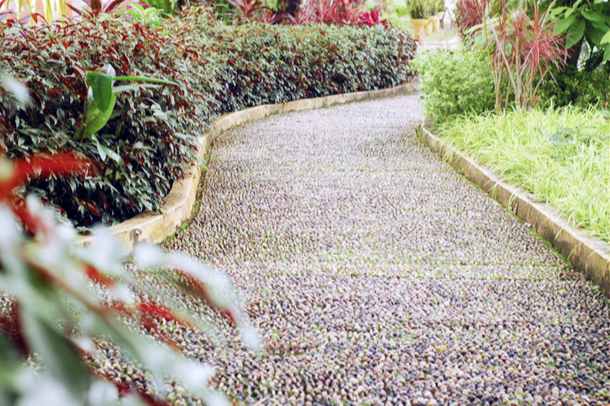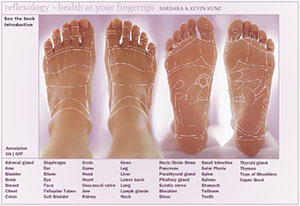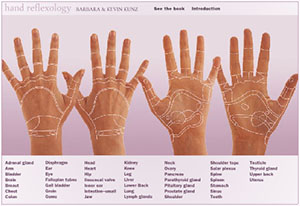Reflexology Paths of Japan
The reflexology paths of Japan are unique among reflexology paths of the world. The Reflexology Paths of Japan are designed to work each and every specific reflex area of the foot with carefully designed and crafted walking surfaces.
- The paths commonly found throughout Asia consist of a sidewalk- like walking surface of embedded stone surface extending for the full length of the walk.
- X
- Elements from nature such as bark, logs, stones, moss, mud and more are found on the barfusspads (bare foot paths) of Germany. Such paths target all reflex areas of the foot with occasional specific pressure applied to a reflex area as the foot meets a well placed object.
In the classic Shiseido design (see below), nine segments of underfoot materials targeting specific parts of the foot and associated with specific reflex areas are placed in side-walk like sections, some of which are repeated over the course of the path.
- The path begins with three types of gravel embedded in mortar each in a separate segment. This section is designed to work all reflex areas except those in the arch.
- X
- In another segment, rounded log halves apply pressure to the reflex areas of the arch, echoing the Japanese tradition of takefumi, stepping on halved bamboo.
- X
- A bridge is included both for beauty and echoing the bridges placed in the traditional Japanese garden to provide stimulation to reflex areas of the toes when walking up and to reflex areas of the arch.
- X
- Further segments include small gravel, large flat stones with sharp edges.
Another feature unique to many Japanese paths is the “stepping in place” feature. Here the path walker pauses and steps in place on an embedded rock designed to work a specific, hard-to-reach reflex area. Typically, the base of the toes, the eye / ear reflex area or the arch, is targeted.
The reflexology paths of Japan are found in urban areas and park settings:
- City parks, nature parks, fitness facilities, natural hot springs businesses, business parks, even a car park garage and the roof of a sewerage treatment plant.
- X
- In some instances the Paths are included in theme parks with hot springs and / or facilities for traditional bathing.
History of reflexology paths of Japan
Most of Reflexology Paths of Japan are variations on the country’s first reflexology path at a Shiseido cosmetics factory.
- It was designed by and built under the direction of Mr. Abe Shunichi around 1990.
- X
- Mr. Shunichi was given the task of helping his company’s health by considering construction of a health facility. (“Our factory manager’s policy is that ‘good products cannot be produced by staff with health problems.'”)
- X
- A walking path and gym with equipment were both considered but then Mr. Shunichi drew on his personal experience with reflexology and decided to build a path to walk on and receive the benefits of reflexology. Mr. Shunichi was inspired by the work of Father Josef Eugster of Taiwan whose reflexology work has inspired use of the reflexology idea throughout Asia.
The true genius of Mr. Shunicihi’s work was to design individual segments in the sidewalk-like structure.
- Each individual segment would include rocks specific to working each of reflexology’s reflex areas.
- X
- Various materials were tested and a decision resulted that nine patterns “suitably press the Rwo-Shr points.”
- X
- The original Shiseido reflexology path is a seventy-five meter walk around an irregular rectangle, surrounded by green grass, trees and a picnic table.
- X
- The walking time is 15 minutes.
- X
- And, yes, research at Shiseido showed his efforts accomplished an improved productivity and a gradual decrease in health care costs. The reflexology paths around Japan are funded both by business and government.
- X
- Such efforts draw on a rich history of reflexology, expectations for health improvement with its use, and a tradition of self reliance in working toward health oneself or within the family.
- X
- Such a part of life are the paths that Web sites include maps with locations and tourism Web sites list opinions on the various reflexology paths.
- X
- Also judged are the foot baths or hot springs frequently located with paths.
- X
- Pretty scenery is appreciated as noted by one reflexology path walker who enjoyed: the “sound of the waves and smell of pine. And better blood flow in the legs as pleasantly, to promenade along the shoreline intact. Comforted by just looking out in the sea breeze while the ocean. Unfortunately in today’s overcast, but could not see, who want to horizon, blue sky and waves are received in return, always majestic Fuji can be seen from here.”
- X
- Of another path it is noted: “Layout is monotonous, gentle stimulation. The sense of satisfaction is not enough.”
A Virtual Tour of the Reflexology Paths of Japan
As you embark on your virtual tour of the reflexology paths of Japan, notice common elements:
- Differing embedded stone sizes
- X
- A by-pass (with one side for a more ouch-producing stone size and the other half a less challenging stone size)
- X
- A bridge with halved logs (for working the toes)
- X
- Halved logs in pavement, hand rails for support
- X
- Foot reflexology charts displayed for reading
- X
- Signs noting which part of the foot the particular segment is intended
Shiseido
A design plan very similar to the original reflexology path at Shiseido is pictured here. A construction company was also launched to build reflexology paths. Pictured is an indoor reflexology path suitable for a small room in the house and priced at 4,000,000 Yen including installation.
Other Shiseido reflexology path products for sale including an larger indoor path (250,000 Yen) and a cobblestone mat (2,500 Yen).
Hatagaya Building in Shibuya-ku section of Tokyo
It doesn’t get better than this urban reflexology path in the shadow of the Hatagaya Building in the Shibuya-ku section of Tokyo. The path is integrated into a beautifully landscaped setting with all the underfoot elements that make a total Japanese reflexology path experience: various rock surfaces, a bridge feature, stand-in-place stepping elements and, to cap it all off, a water walkway for children resembling a gently flowing, rock carpeted mountain stream (although as an adult I’d certainly want to try it.).
Pine Forest on the Coast (Yaizu Discovery Park in Shizuoka Prefecture)
A lovely natural setting makes for an outstanding reflexology path located in a pine forest on the coast. This path was the most frequently mentioned and pictured during an Internet survey. One individual notes the smell of the pine forest and (being) “Comforted by just looking out in the sea breeze while the ocean.” In addition, “always majestic (Mount) Fuji can be seen from here.” Detailed photos are posted. A famous planetarium and heated pool are also located at the Discovery Park.
Hot Springs / Historical Theme Park
“Footbath gardens” are a part of a historically themed hot springs. “At the Oedo Onsen Monogatari near Tokyo, the Edo Period is recreated.” Visitors put on “yukata (casual cotton kimono in different colours, different designs and in different sizes) & matching sash.” The visitor can “walk on the foot reflexology path or bath your feet while seated around a square footbath. “Cost: “2,827 Yen for Adults, 1,575 Yen for Children. Extra for massage, foot reflexology, sand sauna.”
Asahi-city Sports and Outdoor Attractions
A city sports facility includes baseball field, tennis courts, a gymnasium and reflexology path. The surroundings for a walk on the path are pretty spartan. Close-up photos of individual segments of the reflexology path help envision the Japanese design. (These segments look the same as those pictured at the Discovery Park at Yaidu making one wonder it there is a manufacturer for these segments or at least a blueprint.). Included are single stones embedded in foot outlines to work very specific parts of the foot. Note also the use of the word “fingers” intended to mean “toes” on a segment of the path consisting of straight lines of stones where one is meant to stand and step in place, exerting pressure at the base of the toes.
Kakegawa-City School Reflexology Path
Reflexology Path between school buildings includes path segments paired with diagram of showing placement of the particular segment.
Spa Hotel with Health Experiences
A spa hotel in Toyota City, Aichi Prefecture offers a two-floor bathing / health experience.
- On one floor one receives admission to: a medicated bath (with bath of the week), cypress bath, outdoor bath, large tub with jacuzzi (price: 600 yen for adults / 300 yen for children).
- X
- The second floor includes: reflexology (health) promenade, eight different jacuzzis, hot bed, sauna, mist sauna, infrared warming rooms, bath walking (price: 700 yen for adults / 400 yen for children). Admission to both floors is 1,200 yen for adults and 500 yen for children.
Kusu Otter Footbath Water Park: Theme Park and Health Spa
Visitors can walk the reflexology path (“Boardwalk pressing points in the soles of the feet”), drink water from the hot spring (“Hot springs or spring water drinking can have health benefits”) or sit and soak feet in a footbath.
Fukuroi Aino
Includes a critique of this city park feature‹”Layout is monotonous, gentle stimulation. The sense of satisfaction is not enough.” See above.
Roof Top of a Sewage Treatment Plant
Situated in the corner of a park is a water treatment plant in Shizuoka City with a roof top lawn, flower garden and reflexology path.
Park across from Tokushukai Hospital, Shizuoka City
A park across from the hospital includes a unique reflexology path: “gentle touch foot walkway” with elements made of wood. Designed after three years of input from hospital workers and locals. (GeoCities origin).
Promenade health spa footbath Kamisuwan in Japan’s “Northern Alps”
“,,,adjacent to Geyser Park Lake Suwa and Suwa foot bath with views of the Northern Alps and sit on the bench, boardwalk to stimulate acupuncture points of foot healthŠ” While no photos of the reflexology path are available, photos of the surrounding mountain area near Nagano show the inclusion of a path in a mountain spa. It is noted that: “‘Road nature stroll bath’ in bare feet and step on the panel that was created to stimulate the acupuncture points projections, promote blood circulation, which ensure better health. Surprisingly difficult to walk, but it hurts, that’s why it is effective.” [Click to view pictures]
Elusive Reflexology Paths of Japan
As a researcher it doesn’t get any better than the “wow” moment when the hunt for the elusive Japanese reflexology path finally came together: the thrill of the hunt, the pleasure of
discovery, that moment of realization bringing together layers of research over twenty years—wow.
I knew it had to be there on Google translate somewhere—the Reflexology Paths of Japan. The topic is so popular and the paths in China are so extensive, I knew Japan must have lots but my searches were fruitless.
Then I combined my discoveries. I knew “foot reflex” was the term to use when searching instead of “reflexology” to find reflexology information in the Japanese language Google translate. “Path” didn’t help—until I noticed the use of “promenade” on two sites I could find. Plugging in “foot reflex promenade,” I came across the Mother Lode. Web site after Web site of reflexology paths complete with extensive photos.
But the discoveries didn’t stop there. Now that I was in, seeing path after path, I suddenly noticed that many repeated the same elements: differing embedded stone sizes, a bridge, a by-pass (with one side for a more ouch-producing stone size and the other half a more gentle stone size). Yes, the configurations varied with the site available for placement of the reflexology path but I must admit I was truly moved when realized what I was looking at.
You see, the paths were replications of the original reflexology path at a Shiseido factory designed by and built under the direction of Mr. Abe Shunichi around 1990. Yes, Mr. Shunichi created an amazing blueprint for a generation of reflexology paths to come, impacting the health of his country by an unimaginable measure. (See below.) And, yes, research at Shiseido showed his efforts accomplished an improved productivity and a gradual decrease in health care costs.
As noted in “reflexology Paths of Japan” Mr. Shunichi was given the task of helping his company’s health by considering construction of a health facility. (“Our factory manager’s policy is that ‘good products cannot be produced by staff with health problems.’ A walking path and gym with equipment were both considered but then Mr. Shunichi drew on his personal experience with reflexology (see below) and decided to build a path to walk on and receive the benefits of reflexology. The true genius of Mr. Shunicihi’s work was to design individual segments in the sidewalk like structure. Each individual segment would include rocks specific to working each of reflexology’s reflex areas. Various materials were tested and a decision resulted that nine patterns “suitably press the Rwo-Shr points.”
What was truly moving was the realization that the efforts of one man would have such profound impact.
I applaud Mr. Shunichi’s efforts but, you see, it was the realization, once again, that the work of Father Josef Eugster, had done so much to change our world yet again. You see, Mr. Shunichi became familiar with reflexology when he lived in Taiwan in 1983 and his wife was taken ill with gastritis that demanded continual medication. Mr. Shunichi and his wife were told about and started applying “the Rwo-Shr.” Rwo-Shr translates from Mandarin Chinese as “Josef.” It is
the reflexology method named after Father Josef. In brief, however, let me say that Father Josef is quite literally a one-man army whose reflexology work, revived from ancient Chinese practices, created an enthusiasm for an idea that stormed the Asian continent.
Today Father Josef’s influence is all pervasive throughout Asia. Whole industries of reflexology products, practitioners, and, yes, reflexology paths started with one man working with ancient traditions. In Asian cultures where expectations of self-reliance in health is accepted and expected, reflexology was and is an idea whose time has come—thanks to Father Josef.
I really don’t know what to say at this point in my search for the Japanese reflexology path. I’ve come full circle through many years—Kevin and I met Mr. Shunichi and Father Josef at a Tokyo conference in 1990 and have studied their ideas since. I appreciate: the “wow” moment; the demonstration that an idea developed and expanded can have profound impact; the blueprint of what we in other countries can do to better our citizens’ health and, perhaps most of all, the clear message of the ability of one person to create a better world.









